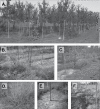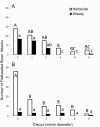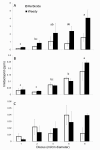Evaluation of Systemic Imidacloprid and Herbicide Treatments on Flatheaded Borer (Coleoptera: Buprestidae) Management in Field Nursery Production
- PMID: 33080001
- PMCID: PMC7724753
- DOI: 10.1093/jee/toaa228
Evaluation of Systemic Imidacloprid and Herbicide Treatments on Flatheaded Borer (Coleoptera: Buprestidae) Management in Field Nursery Production
Abstract
The flatheaded appletree borer, Chrysobothris femorata (Olivier) (Coleoptera: Buprestidae), and related species are deciduous tree pests. Female beetles prefer to oviposit at tree bases, and larvae tunnel beneath the bark, which weakens or kills young or newly transplanted trees. In the first objective of this study, Discus N/G (2.94% imidacloprid + 0.7% cyfluthrin) applied at six lower-than-labeled rates (0.0, 0.98, 1.97, 3.94, 5.91, and 7.87 ml/cm of average trunk dia.) was evaluated for protection of field-grown maples. A second objective evaluated imidacloprid with and without herbicides to assess the impact of weed competition at the tree base on insecticide effectiveness. A third objective determined relative imidacloprid concentrations in leaf tissue samples with ELISA and related to insecticide rates, herbicide treatments, and the level of flatheaded borer protection. In two trials, higher rates of insecticide were more effective at protecting trees, with rates ≥3.94 ml product/cm trunk diameter performing equivalently. Weed-free trees had more borer attacks and grew faster than trees in weedy plots. Imidacloprid content in leaf tissues had a trend for higher concentrations in smaller, weedy trees in the first season, but that pattern disappeared in subsequent years. Based on fewer attacks in weedy versus weed-free trees (60-90% reduction), it was concluded that weed presence can reduce borer attack success in nurseries independent of insecticide treatment, but tree growth was reduced by weed presence. In addition, Discus applied at rates >3.94 ml/cm did not confer added borer damage protection in weedy plots.
Keywords: Acer; competition; insect suppression; maple; neonicotinoid.
© The Author(s) 2020. Published by Oxford University Press on behalf of Entomological Society of America.
Figures



References
-
- Addesso K. 2019. National Plant Diagnostic update on buprestid detections, pp. 53− 55. InOliver J and Addesso K [eds.]. Proceedings of the Flatheaded Borer Workshop. Tennessee State University, Otis L. Floyd Nursery Research Center, McMinnville, TN: https://bugwoodcloud.org/CMS/mura/sipmc/assets/File/UPDATED%20Proceeding... (last accessed 25 Sept. 2020).
-
- Adkins C, Armel G, Chappell M, Chong J C, Frank S, Fulcher A, Hale F, Ivors K, Klingeman W III, LeBude A, . et al. 2010. Pest management strategic plan for container and field-produced nursery crops in GA, KY, NC, SC, TN, pp. 50− 53. InFulcher A. (ed.), Southern Integrated Pest Management Center, Raleigh, NC.
-
- Altland J E, Gilliam C H, and Wehtje G. 2003. Weed control in field nurseries. HortTech. 13: 9− 14.
-
- [ANSI] American National Standard Institute 2014. American standard for nursery stock (Z60.1-2014). AmericanHort, Columbus, OH.
Publication types
MeSH terms
Substances
LinkOut - more resources
Full Text Sources

